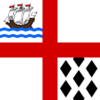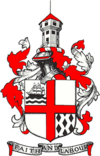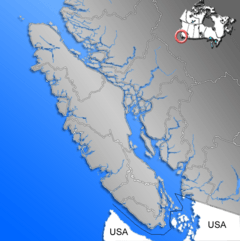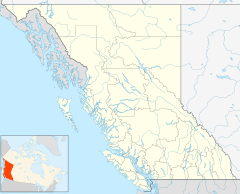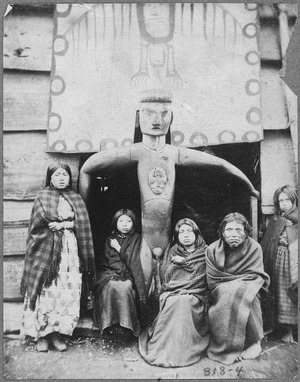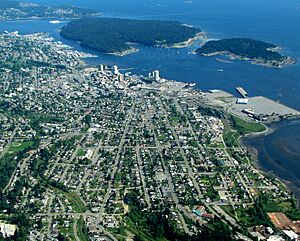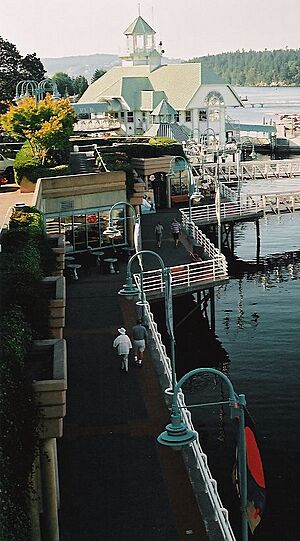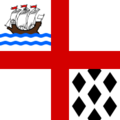Nanaimo facts for kids
Quick facts for kids
Nanaimo
|
|||
|---|---|---|---|
| City of Nanaimo | |||
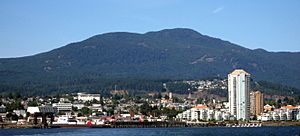
Nanaimo in 2005, from the Strait of Georgia
|
|||
|
|||
| Nickname(s):
Hub City, The Harbour City
|
|||
| Country | Canada | ||
| Province | British Columbia | ||
| District | Nanaimo Regional | ||
| Incorporated | 1874 | ||
| Government | |||
| • Type | Elected city council | ||
| Area | |||
| • City | 91.30 km2 (35.25 sq mi) | ||
| • Metro | 1,280.84 km2 (494.54 sq mi) | ||
| Elevation | 28 m (92 ft) | ||
| Population
(2021)
|
|||
| • City | 99,863 (ranked 57th) | ||
| • Density | 1,104.1/km2 (2,860/sq mi) | ||
| • Urban | 96,415 | ||
| • Metro | 115,459 (ranked 35th) | ||
| • Metro density | 76.5/km2 (198/sq mi) | ||
| Demonym(s) | Nanaimoite | ||
| Time zone | UTC−8 (PST) | ||
| • Summer (DST) | UTC−7 (PDT) | ||
| Forward sortation area |
V9R – V9V, V9X
|
||
| Area code(s) | 250, 778, 236, 672 | ||
Nanaimo is a city of about 100,000 people. It is located on the east coast of Vancouver Island in British Columbia, Canada. People sometimes call it "The Harbour City" or "Hub City." It was called "Hub City" because its streets used to spread out from the shoreline like the spokes of a wagon wheel. It is also quite central on Vancouver Island. Nanaimo is the main city for the Regional District of Nanaimo.
The city is connected by the Island Highway, the BC Ferries system, and its regional airport. There is also a railway line called the Island Rail Corridor, but it is not currently in use.
Contents
- Discovering Nanaimo's Past
- Nanaimo's Location and Natural Features
- Getting Around Nanaimo
- People and Culture in Nanaimo
- Nanaimo's Economy
- Media and Education
- Pacific Biological Station
- Arts and Culture in Nanaimo
- Sports and Fun Activities
- Famous People from Nanaimo
- Sister City
- Images for kids
- See also
Discovering Nanaimo's Past
The original people of the Nanaimo area are the Snuneymuxw. The city's name, Nanaimo, comes from an English way of saying and spelling their name.
Early European Visits
The first Europeans to reach Nanaimo Harbour were from a Spanish trip in 1791. This trip was led by Juan Carrasco and Francisco de Eliza. They named the harbour Bocas de Winthuysen. Later, in 1852, the British Hudson's Bay Company (HBC) started a settlement here. They called it Colvile Town. In 1858, it was renamed Nanaimo, after the local Indigenous people. The city has been known as "The Harbour City" since before Expo 86.
The Story of Coal in Nanaimo
The Hudson's Bay Company tried to start a coal mine in another area, but it didn't work out. In 1850, a Snuneymuxw Chief named Che-wich-i-kan, also known as "Coal Tyee," showed samples of coal in Victoria. A company worker was sent to check it out, and then Governor James Douglas visited the future site of Nanaimo.
The Snuneymuxw people wanted to sell coal but keep control of it. They wanted to be the only ones to mine it. Chief Wun-wun-shum offered to sell coal for five barrels in exchange for one blanket. The HBC representative, Joseph William McKay, thought this was "impertinent." The Snuneymuxw kept some rights to the coal for a while. But they slowly lost them to other tribes and miners. These miners came from the failed Port Rupert project.
By 1852, the first coal from Nanaimo was shipped out on a boat called the Cadboro.
Building the Nanaimo Bastion
Construction of the Nanaimo Bastion started in 1853. It was finished in 1855.
New Settlers Arrive
On November 27, 1854, 24 coal miners and their families arrived from England. They came on the ships Beaver and Recovery. They had traveled for seven months on a ship called Princess Royal. They were greeted by Joseph William McKay and 21 Scottish miners.
Nanaimo's Chinatowns
In the late 1800s, many immigrants from China came to Nanaimo. They started what was known as the first Chinatown in the 1860s. It was the third largest Chinatown in British Columbia. In 1884, due to rising tensions, a coal company helped move Chinatown outside the city limits.
In 1908, two Chinese business owners tried to raise rents. The community and 4,000 shareholders bought a new site for the third Chinatown. This Chinatown was on Pine Street. It burned down on September 30, 1960, but it was mostly empty by then. A fourth Chinatown, also called Lower Chinatown, grew in the 1920s on Machleary Street.
Nanaimo's Location and Natural Features
Nanaimo is on the east coast of Vancouver Island. It is about 111 kilometers (69 miles) north-west of Victoria. It is also about 55 kilometers (34 miles) west of Vancouver. The Strait of Georgia separates Nanaimo from Vancouver. You can travel to Vancouver by BC Ferries from Horseshoe Bay or Tsawwassen.
Nanaimo is a great starting point for exploring other places. You can visit Tofino, Comox Valley, Parksville, and Campbell River to the north. You can also visit nearby islands like Saysutshun, Protection Island, and Gabriola Island. A new private ferry service, Hullo, started in August 2023. It connects Nanaimo to Vancouver.
Buttertubs Marsh Bird Sanctuary
Buttertubs Marsh is a special place for birds in the middle of Nanaimo. The marsh covers about 100 acres (40 hectares). Part of it, the 46-acre (19-hectare) "Buttertubs Marsh Conservation Area," is protected by the Nature Trust of British Columbia.
Nanaimo's Climate
Nanaimo has a mild climate, like much of coastal British Columbia. Winters are mild and rainy, and summers are warm and dry. Because of its dry summers, it has a Mediterranean-like climate.
Sometimes, there is heavy snowfall in winter. The most snow in one day was 74 centimeters (29 inches) on February 12, 1975. However, the average maximum snow cover is only 20 centimeters (8 inches).
The hottest temperature ever recorded in Nanaimo was 40.6°C (105.1°F) on July 16, 1941. The coldest temperature was -20.0°C (-4.0°F) on December 30, 1968.
Getting Around Nanaimo
Nanaimo has several ways to travel.
Airports and Ferries
There are two airports in Nanaimo. Nanaimo Airport (YCD) has flights to Vancouver, Toronto, and Calgary. Nanaimo Harbour Water Aerodrome (ZNA) has flights to Vancouver Harbour and Sechelt.
Nanaimo also has three BC Ferry terminals. The downtown terminal goes to Gabriola Island. Departure Bay and Duke Point terminals connect to Horseshoe Bay and Tsawwassen respectively.
A private passenger ferry connects Nanaimo Harbour to Protection Island. A seasonal ferry also runs between Swy-a-Lana Lagoon and Saysutshun (Newcastle Island Marine) Park. Since 2023, Hullo offers a fast passenger-only ferry service between downtown Nanaimo and downtown Vancouver. This trip takes 75 minutes.
Roads and Public Transit
Highways 1, 19, and 19A go through Nanaimo. Highway 19 (Nanaimo Parkway) is a bypass road west of the city. Highway 1 and 19A go through Nanaimo as main roads.
Bus service is provided by Nanaimo Regional Transit. It offers service within the city and connects to nearby towns like Parksville, Qualicum Beach, Ladysmith, and Duncan.
The Island Rail Corridor railway line runs through Nanaimo. It has a base and yard in the downtown waterfront area.
Nanaimo Port Authority
The Nanaimo Port Authority manages the inner Harbour Basin marina for smaller boats. It also has the W. E. Mills Landing and Marina for larger vessels. The Port Authority operates two cargo terminals, one near downtown and one at Duke Point. In 2011, a $22 million cruise ship terminal was added at Assembly Wharf. It can handle large cruise ships and offers customs clearance.
People and Culture in Nanaimo
Population and Demographics
In 2021, Nanaimo had a population of 99,863 people. The average age in Nanaimo in 2016 was 45.5 years old. This is a bit older than the national average for Canada.
Most people in Nanaimo speak English. In 2016, 86.7% of residents said English was their first language. Other common first languages include Chinese, French, German, and Punjabi.
Religious Groups
According to the 2021 census, many people in Nanaimo do not follow a specific religion (62.2%). Christianity is the largest religious group (32.1%). Other religions include Sikhism, Islam, Hinduism, and Buddhism.
Nanaimo's Economy
In the past, coal mining was the main business in Nanaimo. Then, in the 1960s, the forestry industry took over. A large pulp mill called Harmac was built in 1958. Today, this pulp mill is owned by its employees and local investors. It brings a lot of money into the local economy. Sometimes, the mill makes the area smell like sulfur. The biggest employer in Nanaimo is the provincial government. Service, retail, and tourism are also very important to the economy.
Technology is also growing in Nanaimo. Companies like "Inuktun" are here. There is also Innovation Island, which helps new technology companies in Nanaimo. It gives them access to tools, education, and funding.
The average price of houses in Nanaimo in 2011 was about $350,000. There has been a lot of new building downtown, including a waterfront conference center. Some people think this helps the economy. Others worry about blocked views and more traffic.
Media and Education
Local News and Radio
Nanaimo has one newspaper, the Nanaimo News Bulletin. It is published twice a week. Two other newspapers, The Harbour City Star and the Nanaimo Daily News, have closed down.
Nanaimo also has local TV news bureaus for CTV 2 Victoria and CHEK-DT. For radio, you can listen to CHWF-FM (The Wolf) and CKWV-FM (The Wave). There is also CHLY-FM, a community radio station, and CKAY-FM (ICON Radio).
Schools and Universities
Nanaimo has over 30 elementary and secondary schools. Most of these are public schools run by School District 68 Nanaimo-Ladysmith.
Aspengrove School is a private school for students from JrK to grade 12. It is an International Baccalaureate World School. This means it offers special programs for students.
The Conseil scolaire francophone de la Colombie-Britannique runs two French-language schools: École Océane (primary) and École secondaire de Nanaimo (secondary).
The main campus of Vancouver Island University is in Nanaimo. Many international students, especially from East Asia, come to study here.
Pacific Biological Station
The Pacific Biological Station is located on the north shore of Departure Bay. It was started in 1908. It is the oldest fisheries research center on the Pacific coast. This station is part of a network of nine science facilities run by Fisheries and Oceans Canada.
Arts and Culture in Nanaimo
The Port Theatre in downtown Nanaimo hosts many performers and shows throughout the year.
The Nanaimo bar is a famous Canadian dessert. It is a no-bake cookie bar with a creamy custard filling. It is named after Nanaimo!
Nanaimo hosts the yearly Nanaimo Marine Festival. A fun part of the festival is the bathtub race. The race starts in the Nanaimo Harbour downtown. Racers go around Entrance Island, then north-west to Winchelsea Islands, and finish back in Departure Bay.
Sports and Fun Activities
- Nanaimo has the largest sports club on Vancouver Island, the Nanaimo United Football Club. It has over 1,700 members and is one of Canada's oldest sports clubs, started in 1903.
- Nanaimo is home to North America's first legal, purpose-built bungee jumping bridge. It is run by WildPlay Element Parks.
- The city has the Canadian Junior Football League's Vancouver Island Raiders. They play at Caledonia Park.
- Nanaimo is home to the British Columbia Hockey League's Nanaimo Clippers (hockey) and the Western Lacrosse Association's Nanaimo Timbermen (lacrosse). Both teams play at the Frank Crane Arena.
- The Nanaimo Buccaneers play in the Vancouver Island Junior Hockey League at the Nanaimo Ice Centre.
- The Nanaimo NightOwls, a baseball team in the West Coast League, play at Serauxmen Stadium.
- Football Nanaimo plays at Pioneer Park.
- Nanaimo has the Senior A lacrosse team, the Timbermen, in the Western Lacrosse Association. There are also Junior A and Junior B Timbermen teams.
- The Nanaimo Hornets Rugby Football Club is part of the British Columbia Rugby Union. It was started in 1888 and is the second oldest rugby club in Western Canada. They play at Pioneer Park.
Famous People from Nanaimo
- Iain Baird, professional soccer player
- Terry Beech, politician
- Red Carr, professional ice hockey player
- Gene Carr, professional ice hockey player
- Justin Chatwin, actor
- Glen Clark, former Premier of British Columbia
- Jimmy Claxton, baseball pitcher who broke a racial barrier in US baseball
- Raymond Collishaw, Canadian World War I flying ace
- Allison Crowe, singer-songwriter and pianist
- John DeSantis, actor
- Michael Edgson, swimmer
- Jodelle Ferland, actress
- David Gogo, blues guitarist
- Paul Gogo, keyboardist for the rock band Trooper
- Christopher Hart, actor and magician
- Al Hill, ice hockey player and scout
- Bob Hindmarch, professor and ice hockey coach
- Constance Isherwood, lawyer
- Christine Jensen, composer and conductor
- Ingrid Jensen, jazz trumpeter
- Susan Juby, author
- Ethan Katzberg, Olympic Gold Medalist and 2023 Hammer throw world champion
- Diana Krall, jazz pianist and vocalist
- Tim Lander, poet
- Marc-André Leclerc, alpinist
- Callum Montgomery, professional soccer player
- Susan Morgan, Oregon politician
- Phil Olsen, Olympian javelin thrower
- Steve Smith, professional downhill mountain biker
- Shane Sutcliffe, boxer
- Kirsten Sweetland, triathlete
- May Tully, vaudeville actress, writer, director
- Lorna Vinden, wheelchair athlete
- Cameron Whitcomb, singer and songwriter
- Layla Zoe, blues and blues rock musician and songwriter
Sister City
Nanaimo has one sister city:
 Saitama (formerly Iwatsuki City), Saitama Prefecture, Japan, since 1996
Saitama (formerly Iwatsuki City), Saitama Prefecture, Japan, since 1996
Images for kids
See also
 In Spanish: Nanaimo para niños
In Spanish: Nanaimo para niños


